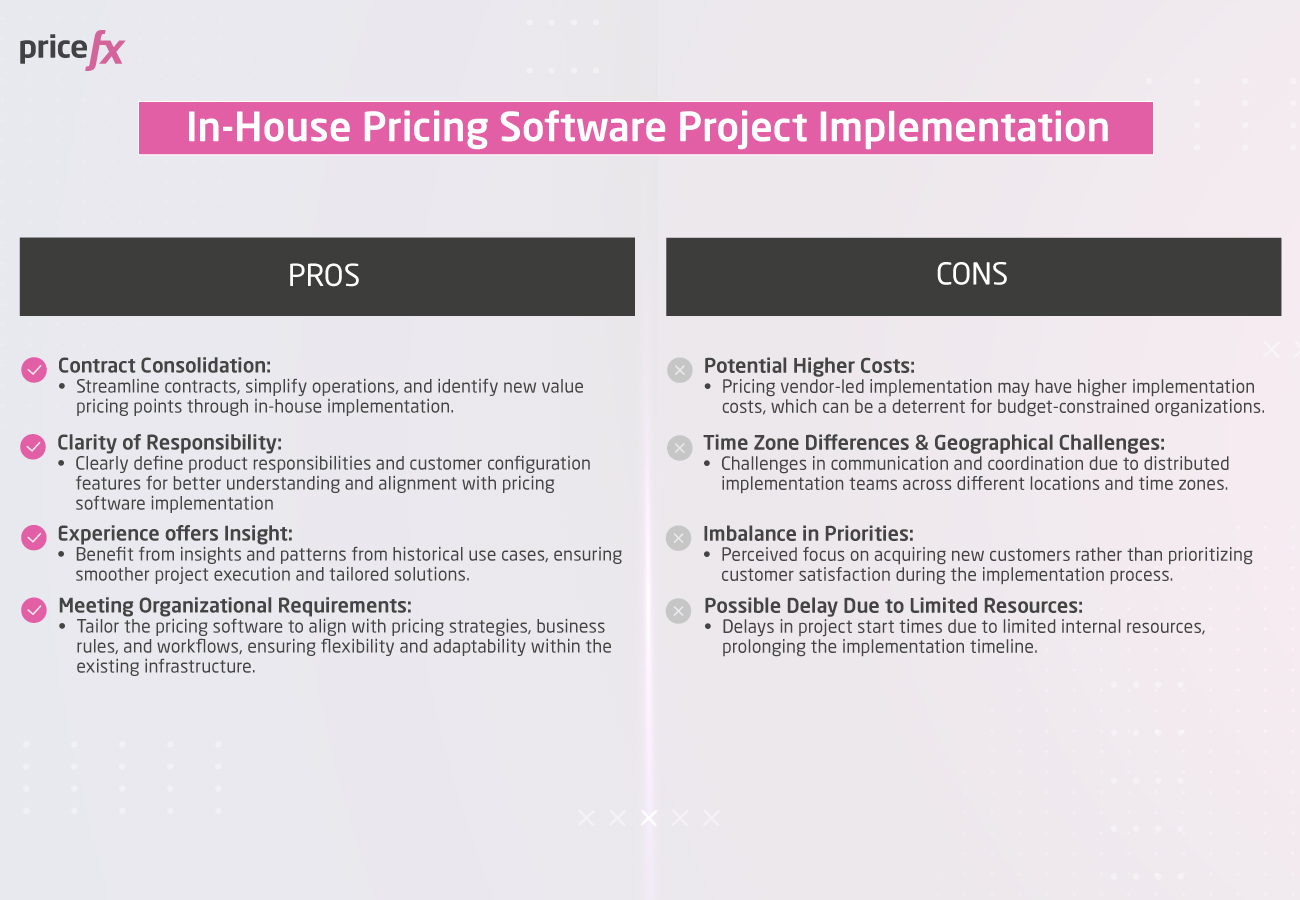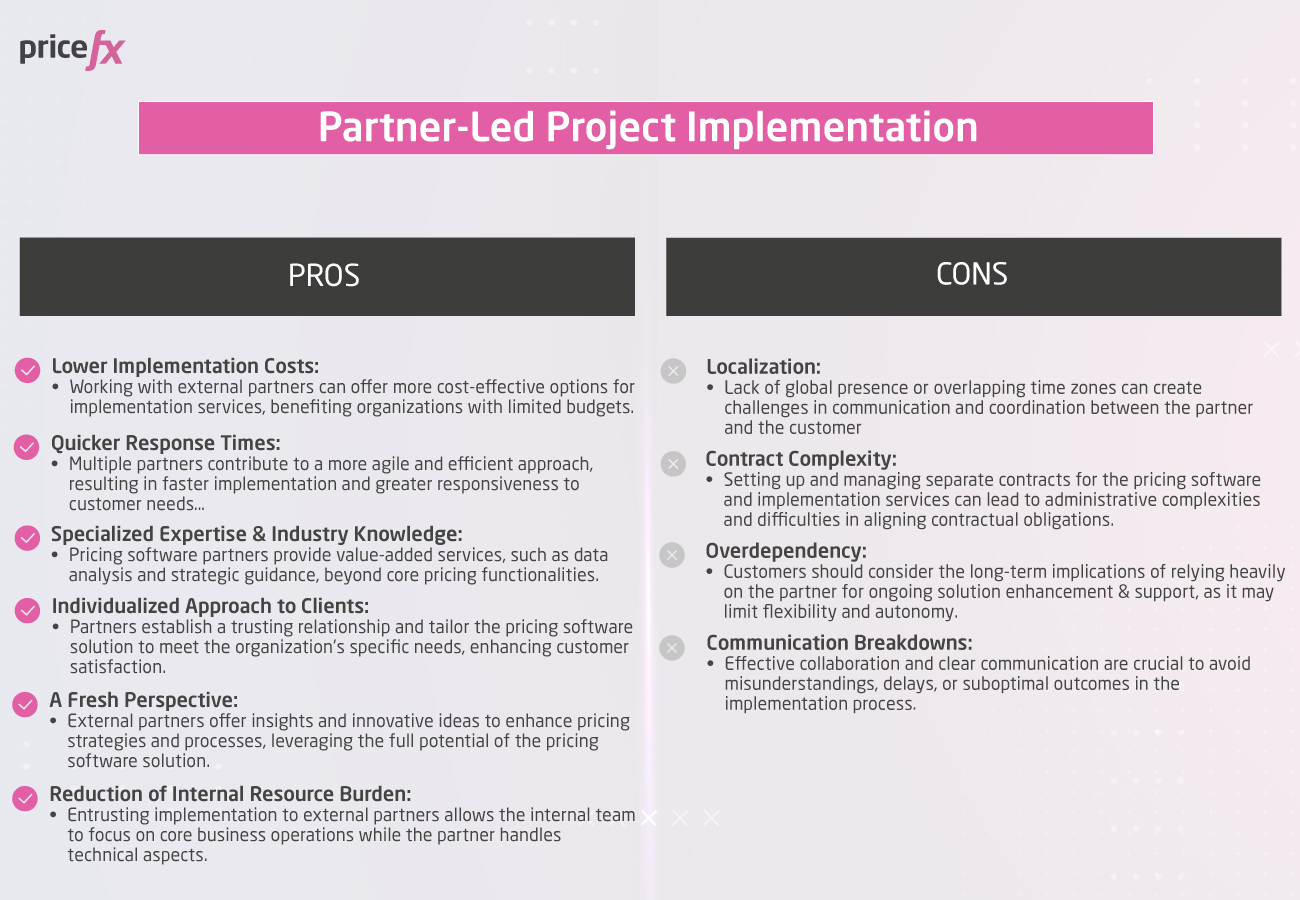In-House vs Partner Software Implementation – Pros & Cons
June 8th, 2023 | 12 min. read
By Tomas Ganaj
Congratulations on identifying that a quality pricing software solution will be exactly the thing to power your organization’s profitable pricing both now and into an evolving future. However, lingering questions remain? Does your IT team have the resources to get the pricing software implemented and driving towards return-on-investment ASAP? Didn’t you just re-deploy them last month to begin work on switching your CRM (Customer Relationship Management) provider? If that scenario sounds familiar, you may want to consider the benefits and drawbacks of an in-house vs partner led pricing software implementation.
With more than 20 years of combined excellence in the pricing industry, TopMonks and Pricefx have helped many clients to identify the exact implementation process that best suits their business. It is never the same and we take pride in identifying the best solution possible for each and every client.
In this article, we will examine in-house vs pricing software partner-led implementation processes and drill down into the pros and cons of each to help you decide the best way forward for your organization with your pricing software project.
What is an In-House Pricing Software Project Implementation?
An in-house pricing software project implementation refers to the process of integrating and deploying a pricing software solution within an organization’s internal infrastructure, led by a pricing vendor. This type of implementation typically involves the installation and configuration of a pricing software system to meet the specific needs of the organization.
During an in-house pricing software project implementation, the pricing vendor usually collaborates closely with the organization’s pricing team to understand their requirements and objectives. The vendor then works on tailoring the software to align with the organization’s pricing strategies, business rules, and workflows. This may involve configuring pricing rules, defining pricing structures, and integrating the software with other existing systems, such as CRM or ERP (Enterprise Resource Planning) platforms. The implementation process also includes data migration, user training, and testing to ensure a smooth transition and effective utilization of the pricing software solution within the organization.

The Pros of an In-House Pricing Software Project Implementation
An in-house pricing software project implementation offers several advantages:
- Contract Consolidation – The consolidation of contracts is particularly beneficial for customers who struggle with managing multiple contracts across various parties or companies. By opting for an in-house implementation, customers can streamline their contracts and have a lower number of agreements, simplifying their business operations leaving them more time and resources to identify new value pricing points and identify opportunities that they never knew they had.
- Clarity of Responsibility – An in-house implementation offers clarity for customers regarding responsibility areas. It delineates the core product responsibilities from the customer configuration features, eliminating any confusion. This clear distinction helps customers understand who is accountable for specific aspects of the pricing software, fostering a better understanding of the overall implementation process. This level of control also allows for a more precise alignment with the organization’s goals and ensures that the pricing software is aligned with their specific business objectives.
- Experience offers Insight – An in-house implementation benefits from a wider portfolio of customer implementations, providing the implementation team with valuable insights and patterns from historical use cases. This allows them to compare future use cases with previous implementations and leverage their experience to ensure smoother and more efficient project execution. Furthermore, pricing software vendors specializing in in-house implementations often focus more on complex projects, making them well-equipped to handle intricate requirements and deliver tailored solutions.
- Meeting Organizational Requirements – By working closely with a pricing vendor, the software can be tailored to align with an organization’s pricing strategies, business rules, and workflows. This configuration enables flexibility and adaptability, ensuring that the pricing software fits seamlessly into the existing infrastructure and supports the organization’s unique requirements.

The Cons of an In-House Pricing Software Project Implementation
However, there are also challenges associated with an in-house pricing software project implementation, notably;
- Potential Higher Costs – With a pricing vendor-led pricing software implementation the cost of implementation may be higher compared to other options. This can be a deterrent for some customers who have budget constraints or are looking for more cost-effective solutions. The expenses associated with configuration and integration of the pricing software system can add up, making it a less attractive choice for organizations seeking lower implementation costs.
- Time Zone Differences & Geographical Challenges – A pricing vendor’s implementation team for in-house projects are often distributed across multiple locations or time zones. This can lead to challenges in communication, coordination, and collaboration. Time differences and geographical distances may result in delays or difficulties in addressing customer concerns or resolving issues promptly. It can also impact the overall efficiency and responsiveness of the implementation process, particularly when urgent support or assistance is required.
- Imbalance in Priorities – Often there may be a perceived imbalance in priorities during an in-house pricing software implementation. Some customers feel that there is a higher focus on acquiring new company logos, i.e., attracting new customers, rather than prioritizing and ensuring prominent levels of customer satisfaction. This can lead to a diminished focus on meeting the unique needs and preferences of individual customers, potentially affecting their overall experience with the pricing software.
- Possible Delay Due to Limited Resources – Another downside can be the potential for longer project start times due to limited internal resources. Organizations may experience delays in initiating the project as they wait for the necessary internal resources to become available. This can prolong the implementation timeline and create frustration for customers who are eager to start benefiting from the pricing software solution.
Who is an In-House Pricing Software Project Implementation FOR?
Usually an in-house pricing software vendor-led implementation process will be better for large national or multinational enterprise level corporations that have the internal resources like a dedicated (and available) IT Team to give energy to the project.
Pricing is a large and complex matter for most businesses and the more resources they have to throw into implementing pricing software, the better.
On the other hand, however, even for a large organization, if the IT Team are engaged in other tasks or the business does not have the presence of a strong and available executive-level decision maker, it could potentially be wise to consider using an implementation partner rather than have the pricing software vendor do the job.
Who is an In-House Pricing Software Project Implementation NOT FOR?
An in-house pricing software project implementation may not be suitable for organizations with limited financial resources or strict budget constraints. The potentially higher implementation costs associated with configuration and integration may pose a significant barrier for such organizations.
Additionally, if an organization lacks the internal expertise or resources required to effectively manage and maintain the pricing software system, an in-house implementation may not be the ideal choice. Outsourcing the implementation and ongoing support to a pricing software partner may be more appropriate for organizations that do not have the capacity or financial means to undertake an in-house pricing software project implementation.
What is a Pricing Software Partner-Led Project Implementation?
An external pricing software partner-led project implementation refers to the process of implementing a pricing software solution with the assistance of an external partner. In this approach, the organization relies on the expertise and guidance of the pricing software partner throughout the implementation process. The external partner takes the lead in configuring the pricing software that the pricing vendor provides to align with the organization’s pricing strategies, business rules, and workflows.
During an external pricing software partner-led implementation, the partner collaborates closely with the organization’s pricing team to understand their requirements and objectives. The partner then utilizes their domain expertise and experience to configure the software, define pricing structures, and integrate it with other existing systems, such as CRM or ERP platforms. The implementation process can include (but may not be limited to) data migration, user training, and testing, ensuring a seamless integration and effective utilization of the pricing software solution.
Many (but not all) implementation partners also offer their clients a pricing strategy development service synchronized to meet the customer’s overarching business objectives.
The Pros of a Pricing Software Partner-Led Project Implementation
There are several advantages to consider when opting for a pricing software partner-led project implementation;
- Lower implementation costs – By working with external partners instead of the pricing software vendor, organizations may at times find more cost-effective options for implementation services. This can be especially beneficial for organizations with limited budgets or those seeking to minimize their upfront expenses.
- Quicker response times – With multiple partners involved, there is typically a more agile and efficient approach to starting the project, addressing incidents, handling requirements, or implementing new features. The partner’s ability to provide prompt responses and solutions contributes to a faster implementation timeline and greater responsiveness to customer needs.
- Specialized Expertise & Industry Knowledge – Beyond the core pricing functionalities, pricing software partners may offer value-added services such as data analysis, competitor monitoring, and strategic guidance. This comprehensive approach helps organizations gain insights and make informed decisions beyond price optimization, building a stronger competitive edge.
- Individualized approach to clients – By establishing a trusting relationship, the partner can often better understand the organization’s unique requirements, goals, and challenges. This personalized approach enhances the implementation process, tailoring the pricing software solution to meet the specific needs of the organization and ensuring a higher level of customer satisfaction.
- A Fresh Perspective – External partners often have a broader view of the market and can offer insights and innovative ideas to enhance the pricing strategies and processes of the organization. They can provide valuable guidance on pricing optimization, revenue management, and leveraging the full potential of the pricing software solution.
- Reduction of Internal Resource Burden – By entrusting the implementation to an external partner, an organization can free up its internal team to focus on core business operations. This allows the internal team to continue their day-to-day responsibilities while the partner handles the technical aspects of the implementation.

The Cons of a Pricing Software Partner-Led Project Implementation
Of course, for every upside there is usually a downside too, and there are potential drawbacks to consider;
- Localization – Sometimes a disadvantage can arise from the lack of a global presence or overlapping time zones. If the partner is limited to a specific region or operates within a different time zone than the customer, it can create challenges in terms of communication, coordination, and responsiveness. Timely collaboration and support may be hindered, potentially affecting the efficiency and effectiveness of the implementation process.
- Contract Complexity – Setting up and managing multiple contracts can often be an issue when working with an external pricing software partner. With a pricing software partner-led implementation, the customer needs to establish separate contracts for both the pricing software itself and the implementation services provided by the external partner. This can lead to administrative complexities and potential difficulties in coordinating contractual obligations and ensuring proper alignment between the two parties.
- Overdependency – On some rare occasions, overdependency on the partner for ongoing solution enhancement and support can develop. While an external partner may offer additional services and ongoing solution improvements, customers need to carefully consider the long-term implications of this dependency. It may limit the organization’s flexibility and ability to make changes or enhancements independently in the future. Organizations that prioritize autonomy and self-sufficiency in managing their pricing software may find this aspect of a partner-led implementation restrictive.
- Communication Breakdowns – Effective collaboration and communication between the organization and the external partner is crucial. Clear and frequent communication is crucial to ensure that the partner understands the organization’s specific requirements and goals. If there are gaps in communication or misalignment, it can lead to misunderstandings, delays, or suboptimal outcomes.
Who is a Pricing Software Partner-Led Project Implementation FOR?
Companies that either do not have the available resources to conduct their own implementation in cooperation with their pricing software vendor or have other specific needs or service requirements such as help with developing their pricing strategies for instance, will usually benefit most from a pricing partner-led implementation process.
Who is a Pricing Software Partner-Led Project Implementation NOT FOR?
If your organization has the internal resources to get the job of pricing software implementation independently done and the right level of ‘pricing strategy maturity’ to bring your business goals home, you should consider working directly with your pricing software vendor.
How Can Companies Assess Which Implementation Process They Need?
To determine the most suitable pricing software implementation process, companies should assess their specific needs and priorities. Firstly, evaluating the organization’s internal capabilities and resources is crucial. If the company possesses the necessary expertise and resources to handle the implementation independently, opting for a pricing vendor-led approach may be more suitable. On the other hand, if the organization lacks the expertise or prefers to rely on external guidance, a pricing software partner-led implementation can offer valuable expertise and support.

Additionally, considering the complexity of the project is essential.
If the pricing software implementation requires extensive configuration, integration with multiple systems, or specialized pricing strategies, partnering with an external pricing software partner can provide the expertise needed for a successful implementation.
Alternatively, if the project is straightforward and the organization primarily requires the core functionality of the pricing software, a vendor-led approach might suffice.
Moreover, assessing the long-term objectives and desired relationship with the implementation partner is important. If the company seeks ongoing support, continuous enhancements, and a long-term partnership, a pricing software partner-led implementation may be more beneficial.
Conversely, if the organization prefers a one-time implementation with minimal reliance on external partners, a vendor-led approach can fulfill their requirements.
Will You Be Treated Differently in a Partner-Led Pricing Software Implementation?
In a word, no. You should not see and feel any difference in working together with a pricing software partner in your implementation process. Like any other client, you will be treated with the utmost priority.
If you are an organization on the lookout for pricing software with a strong implementation partner partnership focus across a range of industries and specialty areas of expertise, then you will want to learn more about the Pricefx Advantage Partner Network and TopMonks, one of the key partners.
On the other hand, if you have already completed your company’s research, talk to one of the Pricefx pricing experts now to begin your pricing software journey.
Happy Pricing!

